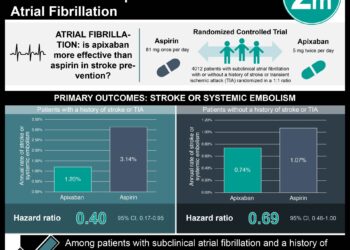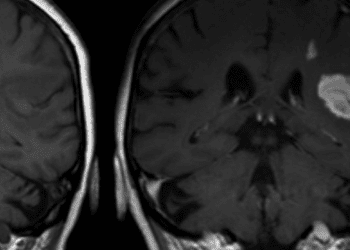[Physician Comment] Intracranial pressure monitoring does not increase survival in patients with traumatic brain injury
 [tabs tab1=”2MM Rundown” tab2= “Full 2MM Report” tab3=”About the Authors”]
[tabs tab1=”2MM Rundown” tab2= “Full 2MM Report” tab3=”About the Authors”]
[tab]
Image: PD/Subdural Hematoma
1. Invasive intracranial pressure monitoring does not improve short- and long-term mortality in patients with severe traumatic brain injury being treated in the intensive care unit.
2. Repeated clinical and radiologic examination may be sufficient to guide management of intracranial pressure in these patients.
The authors demonstrated that continuous intracranial pressure monitoring does not affect short- and long-term mortality in patients with severe traumatic brain injury when compared with repeated clinical and radiologic examination. Moreover, the frequency of neurosurgical monitoring is similar regardless of which treatment protocol is used. Patients receiving ICP monitoring were more likely to receive certain medical interventions; however, the authors attribute this to the continuous nature of ICP measurement, suggesting that temporary fluctuations in ICP may not have been clinically evident to the point that they warranted intervention.
This study is limited by its location, as standard of care and ICU protocols in South America may differ in some respects from those in the United States and elsewhere. Patients did not receive significant post-discharge care, which may have increased 6-month mortality rates. Nonetheless, this study presents an important challenge to the notion that invasive ICP monitoring contributes to improved outcomes in cases of TBI and will certainly spur further study.
Click to read the study in NEJM
Click to read an accompanying editorial in NEJM
[/tab]
[tab]
Image: PD/Subdural Hematoma
Professor Randall M. Chesnut, MD, talks to 2 Minute Medicine Integra Endowed Professor of Neurotrauma, Department of Neurological Surgery, Department of Orthopaedic
 “This prospective, randomized, controlled trial demonstrates that aggressive management of intracranial pressure (ICP) without ICP monitoring produces similar six-month outcomes when compared to guidelines-based management guided by invasive monitoring, albeit associated with longer durations of treatment and more individual interventions. It does not question the value of knowing the ICP; rather it suggests what many of us have suspected for years – that we have vastly oversimplified our interpretation of the monitored ICP value.
“This prospective, randomized, controlled trial demonstrates that aggressive management of intracranial pressure (ICP) without ICP monitoring produces similar six-month outcomes when compared to guidelines-based management guided by invasive monitoring, albeit associated with longer durations of treatment and more individual interventions. It does not question the value of knowing the ICP; rather it suggests what many of us have suspected for years – that we have vastly oversimplified our interpretation of the monitored ICP value.
In settings without ICP monitoring, this study presents the first evidence-based algorithm for aggressive management of severe traumatic brain injury (sTBI) which should be useful for the vast majority of the world’s sTBI population. Unfortunately, this study does not provide guidelines for the clinical interpretation of these data in settings with ICP monitoring. Many of us believe that the proper response is individualizing ICP management based on integrated input from multiple monitoring devices, an approach termed targeted therapy based on multimodality monitoring. Such approaches have been discussed for years; it appears that now it is their time to be formally developed into generally applicable protocols.”
1. Invasive intracranial pressure monitoring does not improve short- and long-term mortality in patients with severe traumatic brain injury being treated in the intensive care unit.
2. Repeated clinical and radiologic examination may be sufficient to guide management of intracranial pressure in these patients.
Primer: Traumatic brain injury (TBI) is defined as an injury to the brain resulting from an external force, direct or indirect, leading to temporary or permanent impairment of brain function. The most common causes are vehicle accidents and penetrating injury, though contact sports and military blast injuries have garnered significant public attention in recent years. Symptoms can range from headache to significant cognitive dysfunction, and in severe cases can lead to death from injury to vital brainstem structures. The latter most often results from increased intracranial pressure (ICP) due to cerebral edema, which exerts downward force on the brainstem and eventually causes it to herniate through openings in the meninges or skull. Additionally, because the brain is enclosed by a rigid skull, increased ICP antagonizes cerebral perfusion pressure and decreases cerebral blood flow, leading to global cerebral ischemia and potential brain death.
The current treatment for TBI is purely supportive. In the acute phase, the most important priority is to ensure that the patient remains medically stable. While this is often not a concern in mild cases, patients with moderate to severe TBI frequently require admission to an intensive care unit (ICU) with involvement of neurointensivists and/or neurosurgeons when available. Intracranial pressure (ICP) monitoring is a key component of care managed by these specialists. Current guidelines recommend ICP monitoring in all patients with TBI and initiating treatment to decrease ICPs when it is above 20 mm Hg. However, some clinicians argue that the physical and radiologic signs accompanying elevated ICPs are sufficient to trigger therapeutic intervention without the need for invasive monitoring devices. In the present study, the authors address this debate by examining the outcomes in patients with TBI whose treatment was managed using directly measured ICPs versus observed clinical and radiologic signs.
Background reading:
- Early Management of Severe Traumatic Brain Injury
- Intracranial Pressure Monitors in Traumatic Brain Injury: A Systematic Review
This [randomized, parallel-group] study: 324 patients, aged 13 years or older, being treated for severe TBI in six ICUs across Bolivia and Ecuador were assigned to treatment protocols based on either directly measured ICP or imaging and clinical exam (ICE) findings. Patients in the ICE group received regular neurologic exams and CT scans at 0, 2, 5, and 7 days and were treated when signs of increased ICP were evident. Patients in the ICP group received placement of intraparenchymal monitoring devices in addition to the monitoring described above, and these patients were treated for ICPs above 20 mm Hg. The authors found no significant difference between these groups in 14-day or 6-month mortality as well as the number of neurosurgical procedures performed. However, hypertonic saline, hyperventilation, and furosemide were given more frequently to the ICP group.
In sum: The authors demonstrated that continuous intracranial pressure monitoring does not affect short- and long-term mortality in patients with severe traumatic brain injury when compared with repeated clinical and radiologic examination. Moreover, the frequency of neurosurgical monitoring is similar regardless of which treatment protocol is used. Patients receiving ICP monitoring were more likely to receive certain medical interventions; however, the authors attribute this to the continuous nature of ICP measurement, suggesting that temporary fluctuations in ICP may not have been clinically evident to the point that they warranted intervention.
This study is limited by its location, as standard of care and ICU protocols in South America may differ in some respects from those in the United States and elsewhere. Patients did not receive significant post-discharge care, which may have increased 6-month mortality rates. Nonetheless, this study presents an important challenge to the notion that invasive ICP monitoring contributes to improved outcomes in cases of TBI and will certainly spur further study.
Click to read the study in NEJM
Click to read an accompanying editorial in NEJM
By [JD] and [RR]
More from this author: PET imaging findings may precede cognitive impairment in patients at high risk for Alzheimer’s disease,Initial dexamethasone improves long-term survival in acute bacterial meningitis, Elevated systolic blood pressure linked to white matter brain damage in young adults, Retired NFL players are at increased risk of death due to neurodegenerative disease
© 2012 2minutemedicine.com. All rights reserved. No works may be reproduced without written consent from 2minutemedicine.com. Disclaimer: We present factual information directly from peer reviewed medical journals. No post should be construed as medical advice and is not intended as such by the authors or by 2minutemedicine.com. PLEASE SEE A HEALTHCARE PROVIDER IN YOUR AREA IF YOU SEEK MEDICAL ADVICE OF ANY SORT.
[/tab]
[tab]
 Jeff Dewey: Jeff Dewey is a 4th year M.D. candidate at the Boston University School of Medicine. Born and raised in the suburbs of St. Paul, MN, he received his undergraduate degree in Biology from Harvard in 2005. He is currently doing research into effects of HIV on subcortical brain structures and cognitive performance. He is planning to pursue a career in neurocritical care. When he’s not studying, he can be found pursuing his missed callings as a ski bum and musician.
Jeff Dewey: Jeff Dewey is a 4th year M.D. candidate at the Boston University School of Medicine. Born and raised in the suburbs of St. Paul, MN, he received his undergraduate degree in Biology from Harvard in 2005. He is currently doing research into effects of HIV on subcortical brain structures and cognitive performance. He is planning to pursue a career in neurocritical care. When he’s not studying, he can be found pursuing his missed callings as a ski bum and musician.
 Rif Rahman: Rif is a 4th year M.D. candidate at Harvard Medical School, currently completing a research year investigating the use of conventional and advanced imaging techniques to assess treatment response of high grade gliomas. His medical interests are in the areas of internal medicine and neurology.
Rif Rahman: Rif is a 4th year M.D. candidate at Harvard Medical School, currently completing a research year investigating the use of conventional and advanced imaging techniques to assess treatment response of high grade gliomas. His medical interests are in the areas of internal medicine and neurology.
[/tab]
[/tabs]




